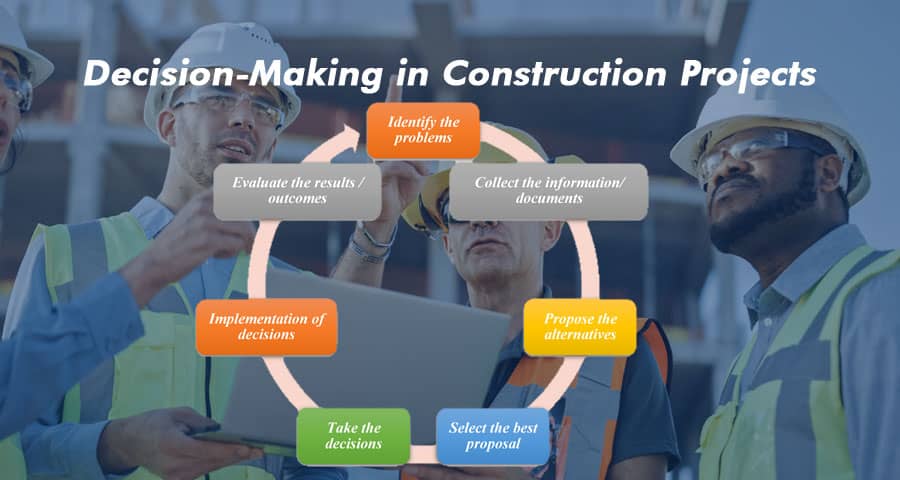Mastering Decision-Making in Construction Projects

In the dynamic realm of construction, decision-making stands as the cornerstone of success. Every choice, from material selection to project scheduling, carries weighty implications that ripple throughout the entire project lifecycle. As construction professionals, we understand the critical role decisions play in shaping outcomes, driving efficiencies, and ensuring client satisfaction.
Understanding the Importance of Decision-Making
Decision-making in construction extends far beyond mere project management; it embodies a multifaceted process that integrates technical expertise, financial acumen, and strategic foresight. At its core, effective decision-making hinges on the ability to assess risks, evaluate alternatives, and make informed choices that align with project objectives. Whether it involves selecting the optimal construction method, negotiating contracts, or resolving conflicts, each decision exerts a profound impact on project outcomes and stakeholder satisfaction.
Factors Influencing Decision-Making in Construction
- Technical Considerations: In the realm of construction, technical considerations form the bedrock of decision-making. From structural design to material specifications, engineers and architects must navigate a myriad of technical variables to ensure structural integrity, durability, and compliance with regulatory standards. Factors such as site conditions, environmental impact, and technological advancements profoundly influence decision-making at every stage of the construction process.
- Financial Implications: The financial dimension looms large in construction decision-making, where cost considerations often dictate project feasibility and profitability. Project managers and financial analysts must carefully weigh the costs of labor, materials, equipment, and overheads against the projected revenues to determine the financial viability of construction projects. Cost-benefit analysis, budgetary constraints, and risk assessment play pivotal roles in guiding investment decisions and resource allocation.
- Stakeholder Expectations: Construction projects involve diverse stakeholders, including clients, investors, regulatory authorities, and the local community, each with their own set of expectations and priorities. Effective decision-making necessitates effective communication and stakeholder engagement to align interests, manage expectations, and mitigate conflicts. By fostering transparent dialogue and cultivating trust, construction professionals can navigate the complex web of stakeholder interests and achieve consensus on critical decisions.
- Regulatory Compliance: Compliance with regulatory requirements and building codes represents a fundamental aspect of construction decision-making. Legal experts and regulatory specialists play a crucial role in interpreting and navigating the myriad of laws, regulations, and permitting processes governing construction activities. By staying abreast of evolving regulatory landscapes and adhering to industry best practices, construction stakeholders can minimize legal risks and ensure compliance with prevailing standards.
Strategies for Effective Decision-Making
- Data-Driven Analysis: In an era defined by data abundance, leveraging data analytics and predictive modeling can empower construction professionals to make more informed decisions. By harnessing data from various sources, including project management software, IoT sensors, and historical performance metrics, stakeholders can gain valuable insights into project trends, identify potential risks, and optimize resource allocation.
- Collaborative Decision-Making: Collaboration lies at the heart of effective decision-making in construction, where multidisciplinary teams collaborate to leverage diverse expertise and perspectives. By fostering a culture of collaboration and knowledge sharing, construction stakeholders can harness collective intelligence to address complex challenges, brainstorm innovative solutions, and make decisions that reflect a consensus-driven approach.
- Risk Management Strategies: Given the inherent uncertainties in construction projects, proactive risk management assumes paramount importance in decision-making. By conducting comprehensive risk assessments, identifying potential threats, and implementing mitigation strategies, construction professionals can preemptively address risks and uncertainties, safeguard project timelines, and protect against unforeseen contingencies.
- Continuous Improvement: Decision-making in construction is an iterative process that demands a commitment to continuous improvement and adaptive learning. By embracing feedback mechanisms, conducting post-mortem analyses, and benchmarking performance against industry peers, construction stakeholders can glean valuable insights, refine decision-making frameworks, and enhance project outcomes over time.
Conclusion
In the fast-paced world of construction, effective decision-making serves as the linchpin of success, driving project efficiency, innovation, and stakeholder satisfaction. By embracing a multidimensional approach that integrates technical expertise, financial acumen, and stakeholder engagement, construction professionals can navigate complex challenges, capitalize on opportunities, and deliver superior outcomes in an increasingly competitive landscape.
